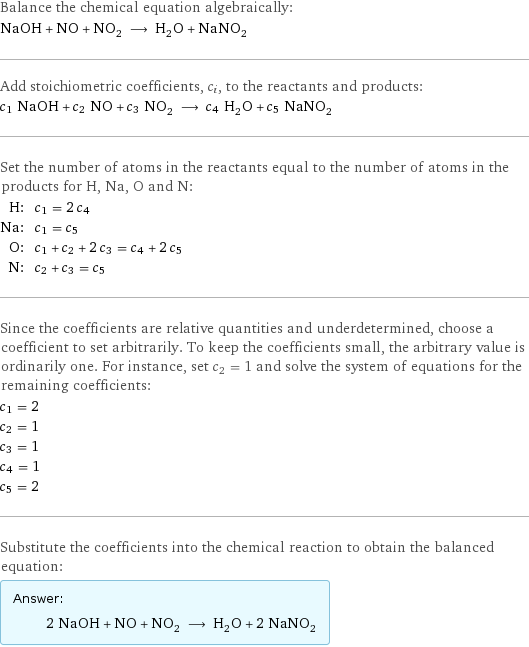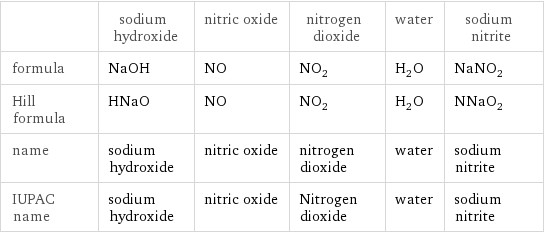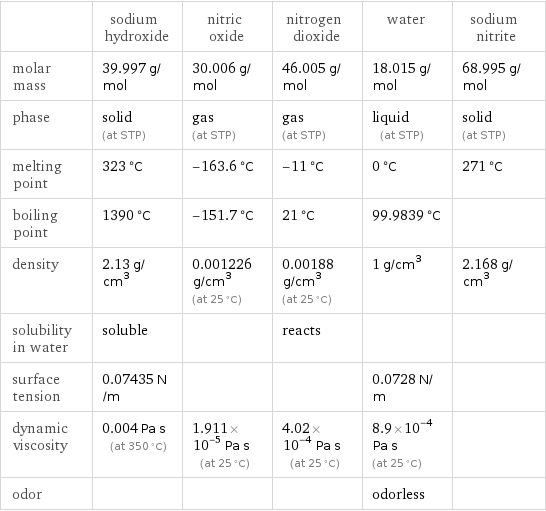Input interpretation

NaOH sodium hydroxide + NO nitric oxide + NO_2 nitrogen dioxide ⟶ H_2O water + NaNO_2 sodium nitrite
Balanced equation

Balance the chemical equation algebraically: NaOH + NO + NO_2 ⟶ H_2O + NaNO_2 Add stoichiometric coefficients, c_i, to the reactants and products: c_1 NaOH + c_2 NO + c_3 NO_2 ⟶ c_4 H_2O + c_5 NaNO_2 Set the number of atoms in the reactants equal to the number of atoms in the products for H, Na, O and N: H: | c_1 = 2 c_4 Na: | c_1 = c_5 O: | c_1 + c_2 + 2 c_3 = c_4 + 2 c_5 N: | c_2 + c_3 = c_5 Since the coefficients are relative quantities and underdetermined, choose a coefficient to set arbitrarily. To keep the coefficients small, the arbitrary value is ordinarily one. For instance, set c_2 = 1 and solve the system of equations for the remaining coefficients: c_1 = 2 c_2 = 1 c_3 = 1 c_4 = 1 c_5 = 2 Substitute the coefficients into the chemical reaction to obtain the balanced equation: Answer: | | 2 NaOH + NO + NO_2 ⟶ H_2O + 2 NaNO_2
Structures

+ + ⟶ +
Names

sodium hydroxide + nitric oxide + nitrogen dioxide ⟶ water + sodium nitrite
Reaction thermodynamics
Enthalpy

| sodium hydroxide | nitric oxide | nitrogen dioxide | water | sodium nitrite molecular enthalpy | -425.8 kJ/mol | 91.3 kJ/mol | 33.2 kJ/mol | -285.8 kJ/mol | -359 kJ/mol total enthalpy | -851.6 kJ/mol | 91.3 kJ/mol | 33.2 kJ/mol | -285.8 kJ/mol | -718 kJ/mol | H_initial = -727.1 kJ/mol | | | H_final = -1004 kJ/mol | ΔH_rxn^0 | -1004 kJ/mol - -727.1 kJ/mol = -276.7 kJ/mol (exothermic) | | | |
Gibbs free energy

| sodium hydroxide | nitric oxide | nitrogen dioxide | water | sodium nitrite molecular free energy | -379.7 kJ/mol | 87.6 kJ/mol | 51.3 kJ/mol | -237.1 kJ/mol | -284.6 kJ/mol total free energy | -759.4 kJ/mol | 87.6 kJ/mol | 51.3 kJ/mol | -237.1 kJ/mol | -569.2 kJ/mol | G_initial = -620.5 kJ/mol | | | G_final = -806.3 kJ/mol | ΔG_rxn^0 | -806.3 kJ/mol - -620.5 kJ/mol = -185.8 kJ/mol (exergonic) | | | |
Equilibrium constant
![Construct the equilibrium constant, K, expression for: NaOH + NO + NO_2 ⟶ H_2O + NaNO_2 Plan: • Balance the chemical equation. • Determine the stoichiometric numbers. • Assemble the activity expression for each chemical species. • Use the activity expressions to build the equilibrium constant expression. Write the balanced chemical equation: 2 NaOH + NO + NO_2 ⟶ H_2O + 2 NaNO_2 Assign stoichiometric numbers, ν_i, using the stoichiometric coefficients, c_i, from the balanced chemical equation in the following manner: ν_i = -c_i for reactants and ν_i = c_i for products: chemical species | c_i | ν_i NaOH | 2 | -2 NO | 1 | -1 NO_2 | 1 | -1 H_2O | 1 | 1 NaNO_2 | 2 | 2 Assemble the activity expressions accounting for the state of matter and ν_i: chemical species | c_i | ν_i | activity expression NaOH | 2 | -2 | ([NaOH])^(-2) NO | 1 | -1 | ([NO])^(-1) NO_2 | 1 | -1 | ([NO2])^(-1) H_2O | 1 | 1 | [H2O] NaNO_2 | 2 | 2 | ([NaNO2])^2 The equilibrium constant symbol in the concentration basis is: K_c Mulitply the activity expressions to arrive at the K_c expression: Answer: | | K_c = ([NaOH])^(-2) ([NO])^(-1) ([NO2])^(-1) [H2O] ([NaNO2])^2 = ([H2O] ([NaNO2])^2)/(([NaOH])^2 [NO] [NO2])](../image_source/b0cfb0cce60aa04f3b543028e97808d7.png)
Construct the equilibrium constant, K, expression for: NaOH + NO + NO_2 ⟶ H_2O + NaNO_2 Plan: • Balance the chemical equation. • Determine the stoichiometric numbers. • Assemble the activity expression for each chemical species. • Use the activity expressions to build the equilibrium constant expression. Write the balanced chemical equation: 2 NaOH + NO + NO_2 ⟶ H_2O + 2 NaNO_2 Assign stoichiometric numbers, ν_i, using the stoichiometric coefficients, c_i, from the balanced chemical equation in the following manner: ν_i = -c_i for reactants and ν_i = c_i for products: chemical species | c_i | ν_i NaOH | 2 | -2 NO | 1 | -1 NO_2 | 1 | -1 H_2O | 1 | 1 NaNO_2 | 2 | 2 Assemble the activity expressions accounting for the state of matter and ν_i: chemical species | c_i | ν_i | activity expression NaOH | 2 | -2 | ([NaOH])^(-2) NO | 1 | -1 | ([NO])^(-1) NO_2 | 1 | -1 | ([NO2])^(-1) H_2O | 1 | 1 | [H2O] NaNO_2 | 2 | 2 | ([NaNO2])^2 The equilibrium constant symbol in the concentration basis is: K_c Mulitply the activity expressions to arrive at the K_c expression: Answer: | | K_c = ([NaOH])^(-2) ([NO])^(-1) ([NO2])^(-1) [H2O] ([NaNO2])^2 = ([H2O] ([NaNO2])^2)/(([NaOH])^2 [NO] [NO2])
Rate of reaction
![Construct the rate of reaction expression for: NaOH + NO + NO_2 ⟶ H_2O + NaNO_2 Plan: • Balance the chemical equation. • Determine the stoichiometric numbers. • Assemble the rate term for each chemical species. • Write the rate of reaction expression. Write the balanced chemical equation: 2 NaOH + NO + NO_2 ⟶ H_2O + 2 NaNO_2 Assign stoichiometric numbers, ν_i, using the stoichiometric coefficients, c_i, from the balanced chemical equation in the following manner: ν_i = -c_i for reactants and ν_i = c_i for products: chemical species | c_i | ν_i NaOH | 2 | -2 NO | 1 | -1 NO_2 | 1 | -1 H_2O | 1 | 1 NaNO_2 | 2 | 2 The rate term for each chemical species, B_i, is 1/ν_i(Δ[B_i])/(Δt) where [B_i] is the amount concentration and t is time: chemical species | c_i | ν_i | rate term NaOH | 2 | -2 | -1/2 (Δ[NaOH])/(Δt) NO | 1 | -1 | -(Δ[NO])/(Δt) NO_2 | 1 | -1 | -(Δ[NO2])/(Δt) H_2O | 1 | 1 | (Δ[H2O])/(Δt) NaNO_2 | 2 | 2 | 1/2 (Δ[NaNO2])/(Δt) (for infinitesimal rate of change, replace Δ with d) Set the rate terms equal to each other to arrive at the rate expression: Answer: | | rate = -1/2 (Δ[NaOH])/(Δt) = -(Δ[NO])/(Δt) = -(Δ[NO2])/(Δt) = (Δ[H2O])/(Δt) = 1/2 (Δ[NaNO2])/(Δt) (assuming constant volume and no accumulation of intermediates or side products)](../image_source/256427c8f9e5a8f60dc887f239e3394d.png)
Construct the rate of reaction expression for: NaOH + NO + NO_2 ⟶ H_2O + NaNO_2 Plan: • Balance the chemical equation. • Determine the stoichiometric numbers. • Assemble the rate term for each chemical species. • Write the rate of reaction expression. Write the balanced chemical equation: 2 NaOH + NO + NO_2 ⟶ H_2O + 2 NaNO_2 Assign stoichiometric numbers, ν_i, using the stoichiometric coefficients, c_i, from the balanced chemical equation in the following manner: ν_i = -c_i for reactants and ν_i = c_i for products: chemical species | c_i | ν_i NaOH | 2 | -2 NO | 1 | -1 NO_2 | 1 | -1 H_2O | 1 | 1 NaNO_2 | 2 | 2 The rate term for each chemical species, B_i, is 1/ν_i(Δ[B_i])/(Δt) where [B_i] is the amount concentration and t is time: chemical species | c_i | ν_i | rate term NaOH | 2 | -2 | -1/2 (Δ[NaOH])/(Δt) NO | 1 | -1 | -(Δ[NO])/(Δt) NO_2 | 1 | -1 | -(Δ[NO2])/(Δt) H_2O | 1 | 1 | (Δ[H2O])/(Δt) NaNO_2 | 2 | 2 | 1/2 (Δ[NaNO2])/(Δt) (for infinitesimal rate of change, replace Δ with d) Set the rate terms equal to each other to arrive at the rate expression: Answer: | | rate = -1/2 (Δ[NaOH])/(Δt) = -(Δ[NO])/(Δt) = -(Δ[NO2])/(Δt) = (Δ[H2O])/(Δt) = 1/2 (Δ[NaNO2])/(Δt) (assuming constant volume and no accumulation of intermediates or side products)
Chemical names and formulas

| sodium hydroxide | nitric oxide | nitrogen dioxide | water | sodium nitrite formula | NaOH | NO | NO_2 | H_2O | NaNO_2 Hill formula | HNaO | NO | NO_2 | H_2O | NNaO_2 name | sodium hydroxide | nitric oxide | nitrogen dioxide | water | sodium nitrite IUPAC name | sodium hydroxide | nitric oxide | Nitrogen dioxide | water | sodium nitrite
Substance properties

| sodium hydroxide | nitric oxide | nitrogen dioxide | water | sodium nitrite molar mass | 39.997 g/mol | 30.006 g/mol | 46.005 g/mol | 18.015 g/mol | 68.995 g/mol phase | solid (at STP) | gas (at STP) | gas (at STP) | liquid (at STP) | solid (at STP) melting point | 323 °C | -163.6 °C | -11 °C | 0 °C | 271 °C boiling point | 1390 °C | -151.7 °C | 21 °C | 99.9839 °C | density | 2.13 g/cm^3 | 0.001226 g/cm^3 (at 25 °C) | 0.00188 g/cm^3 (at 25 °C) | 1 g/cm^3 | 2.168 g/cm^3 solubility in water | soluble | | reacts | | surface tension | 0.07435 N/m | | | 0.0728 N/m | dynamic viscosity | 0.004 Pa s (at 350 °C) | 1.911×10^-5 Pa s (at 25 °C) | 4.02×10^-4 Pa s (at 25 °C) | 8.9×10^-4 Pa s (at 25 °C) | odor | | | | odorless |
Units
